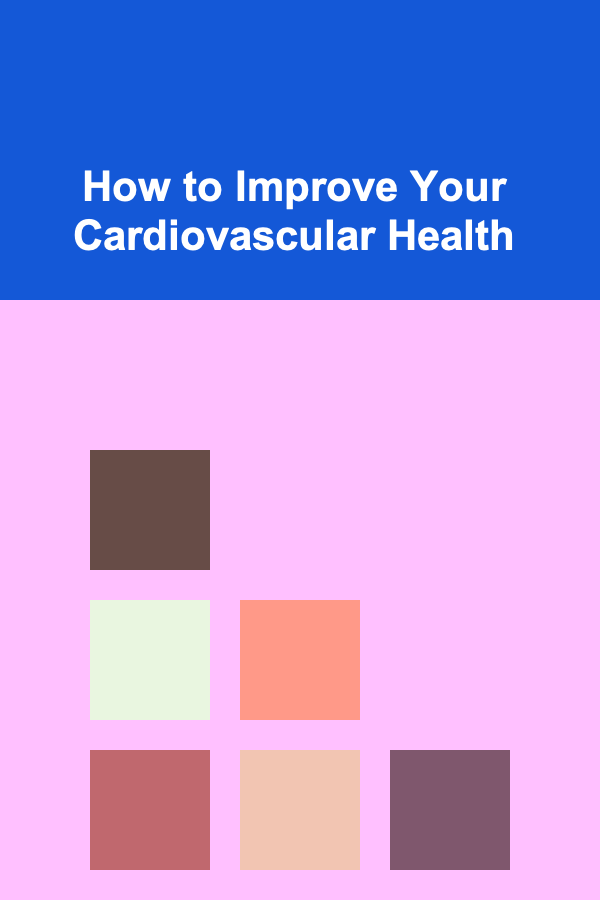
How to Improve Your Cardiovascular Health
ebook include PDF & Audio bundle (Micro Guide)
$12.99$11.99
Limited Time Offer! Order within the next:

Cardiovascular health is essential for maintaining overall well-being and longevity. With the rise in cardiovascular diseases (CVD), including heart disease, strokes, and hypertension, it has become more important than ever to understand how to protect and improve heart health. The cardiovascular system is responsible for transporting blood, nutrients, and oxygen throughout the body, making its proper functioning vital to our survival and health. In this article, we will explore various methods, both lifestyle-related and medical, to improve cardiovascular health and reduce the risks associated with heart disease.
Understanding Cardiovascular Health
Before diving into ways to improve cardiovascular health, it's crucial to understand the heart's structure and the factors that influence cardiovascular health. The cardiovascular system includes the heart, blood vessels (arteries, veins, and capillaries), and the blood that circulates through the body. The heart is a muscular organ that pumps blood to deliver oxygen and nutrients to various tissues and organs. When this system is compromised, it can lead to several health conditions, such as:
- Atherosclerosis: Hardening and narrowing of the arteries due to plaque buildup.
- Coronary artery disease (CAD): A condition where the coronary arteries that supply blood to the heart become blocked or narrowed.
- Heart attacks: Occur when blood flow to a part of the heart muscle is obstructed.
- Stroke: A disruption of blood flow to the brain, leading to the death of brain cells.
- Hypertension (High blood pressure): Increased pressure in the arteries, which can lead to heart failure and other complications.
To mitigate these risks, understanding the factors that affect cardiovascular health is key. These include genetics, lifestyle choices, diet, exercise, stress levels, and overall physical condition. Fortunately, many of these risk factors can be managed, reduced, or even reversed with proper care.
Adopting a Heart-Healthy Diet
One of the most effective ways to improve cardiovascular health is by adopting a heart-healthy diet. Nutrition plays a crucial role in maintaining healthy blood vessels, controlling cholesterol levels, and preventing obesity---factors that directly influence heart disease risk.
A. Foods to Include in a Heart-Healthy Diet
- Fruits and Vegetables: Rich in essential vitamins, minerals, antioxidants, and fiber, fruits and vegetables can help lower cholesterol levels and blood pressure. They are low in calories and high in water content, making them ideal for maintaining a healthy weight.
- Whole Grains: Foods such as oats, quinoa, barley, and brown rice are excellent sources of fiber, which helps reduce bad cholesterol (LDL) levels and keeps the arteries clear.
- Lean Proteins: Lean meats, fish, legumes, and plant-based proteins like tofu and tempeh can provide necessary protein without the added saturated fats found in red meats.
- Healthy Fats: Replacing saturated fats (found in butter, fatty meats, and processed foods) with unsaturated fats (found in olive oil, nuts, seeds, and fatty fish) can help lower cholesterol and improve heart health.
- Fatty Fish: Salmon, mackerel, sardines, and trout are rich in omega-3 fatty acids, which help reduce inflammation, lower triglyceride levels, and improve heart function.
B. Foods to Avoid
- Trans Fats: Found in processed and packaged foods, trans fats raise bad cholesterol and lower good cholesterol, increasing the risk of heart disease.
- Refined Carbohydrates: White bread, sugary cereals, and pastries can spike blood sugar and insulin levels, contributing to obesity and increasing the risk of cardiovascular diseases.
- Excessive Salt: High salt intake can lead to high blood pressure, a key risk factor for heart disease. Limiting sodium can help reduce this risk.
- Sweets and Sugary Beverages: Excess sugar intake can lead to obesity, insulin resistance, and inflammation, all of which are detrimental to cardiovascular health.
C. The Role of Fiber and Antioxidants
Fiber, especially soluble fiber, plays an essential role in reducing cholesterol and improving overall heart health. Foods like oats, beans, and apples provide this crucial nutrient. Antioxidants, found in fruits and vegetables, help reduce inflammation and oxidative stress, both of which contribute to the development of cardiovascular diseases.
Regular Physical Activity
Exercise is another cornerstone of cardiovascular health. Physical activity strengthens the heart, improves circulation, and helps control other risk factors like weight, cholesterol, and blood pressure. Even small amounts of exercise can lead to significant improvements in heart health.
A. Aerobic Exercise
Aerobic exercises, such as walking, jogging, cycling, and swimming, are particularly beneficial for heart health. These activities improve cardiovascular endurance, lower blood pressure, and increase the heart's ability to pump blood effectively. Aerobic exercise helps increase the efficiency of oxygen delivery to tissues and improves overall circulation.
B. Strength Training
While aerobic exercise is crucial for heart health, strength training also plays a role. Resistance exercises like weightlifting and bodyweight exercises (push-ups, squats) help increase muscle mass, which in turn boosts metabolism and contributes to weight loss. Additionally, strength training improves bone health and reduces the risk of developing type 2 diabetes---another significant risk factor for heart disease.
C. Consistency and Intensity
To reap the full benefits of exercise, consistency is key. The American Heart Association recommends at least 150 minutes of moderate-intensity exercise per week, or 75 minutes of vigorous-intensity exercise, spread throughout the week. It's also important to incorporate flexibility and balance exercises into your routine to improve mobility and prevent injury.
Maintaining a Healthy Weight
Obesity is one of the most significant risk factors for cardiovascular disease. Excess weight puts additional strain on the heart, increases the risk of high blood pressure, raises cholesterol levels, and can lead to the development of type 2 diabetes. Managing body weight through a balanced diet and regular physical activity is essential for heart health.
A. The Role of Body Mass Index (BMI)
BMI is a useful tool for assessing whether you are within a healthy weight range. A BMI of 18.5 to 24.9 is considered normal, while a BMI of 25 or higher indicates overweight or obesity. Achieving and maintaining a healthy BMI can significantly reduce the risk of heart disease.
B. Reducing Belly Fat
Visceral fat, the fat stored around the abdominal organs, is particularly harmful to heart health. It can contribute to inflammation, insulin resistance, and an increased risk of heart disease. Losing belly fat through diet and exercise can drastically improve cardiovascular outcomes.
Managing Stress
Chronic stress can have a significant impact on cardiovascular health. Stress activates the body's "fight or flight" response, leading to the release of hormones like cortisol and adrenaline, which can raise blood pressure and heart rate. Long-term stress can lead to inflammation, increased clotting, and plaque buildup in the arteries, all of which contribute to heart disease.
A. Stress Management Techniques
- Mindfulness and Meditation: Mindfulness practices can help reduce stress by promoting relaxation and focusing on the present moment.
- Yoga: Combining physical movement with breath control, yoga has been shown to lower blood pressure, reduce anxiety, and improve heart health.
- Breathing Exercises: Deep breathing exercises can activate the parasympathetic nervous system, helping to reduce heart rate and blood pressure.
B. Healthy Coping Mechanisms
Developing healthy coping mechanisms for stress is crucial. This can include engaging in hobbies, socializing with friends and family, or seeking professional counseling. Avoiding unhealthy coping mechanisms such as smoking or excessive alcohol consumption is also important.
Avoiding Smoking and Limiting Alcohol Consumption
Both smoking and excessive alcohol consumption are major risk factors for cardiovascular disease. Smoking damages blood vessels, reduces oxygen levels in the blood, and increases the risk of clot formation. Alcohol, when consumed excessively, can lead to high blood pressure, obesity, and heart failure.
A. Quitting Smoking
Quitting smoking is one of the most beneficial actions you can take to improve cardiovascular health. Within a year of quitting, the risk of heart disease drops by half. Over time, blood circulation improves, and the heart's ability to function becomes more efficient.
B. Limiting Alcohol
If you choose to drink alcohol, moderation is key. The American Heart Association recommends no more than one drink per day for women and two drinks per day for men. Drinking in moderation helps reduce the risk of high blood pressure and heart disease.
Regular Checkups and Monitoring
Finally, regular checkups with a healthcare provider are essential for monitoring cardiovascular health. Early detection of high blood pressure, high cholesterol, or other heart disease risk factors can lead to timely intervention and treatment, reducing the likelihood of serious health problems in the future.
A. Blood Pressure and Cholesterol Monitoring
Regular monitoring of blood pressure and cholesterol levels helps identify any potential issues early on. If necessary, your healthcare provider may recommend medications or lifestyle changes to manage these conditions.
B. Medical Interventions
In some cases, medications may be necessary to help control blood pressure, lower cholesterol, or prevent blood clots. Working with a healthcare provider to determine the best course of action is crucial to maintaining optimal cardiovascular health.
Conclusion
Improving cardiovascular health is a multifaceted process that involves making informed choices about diet, exercise, stress management, and lifestyle. By focusing on heart-healthy practices such as adopting a balanced diet, exercising regularly, managing weight, reducing stress, and avoiding harmful habits like smoking, you can significantly reduce the risk of cardiovascular diseases. Furthermore, regular monitoring and checkups ensure that any potential problems are identified and treated early, contributing to a longer and healthier life.
Cardiovascular health is not something that can be achieved overnight, but with consistent effort and commitment to healthy living, you can take significant steps toward improving your heart health and enjoying a higher quality of life.

Beginner's Guide to Investing for Beginners
Read More
How to Create a Resource Hub for All Your Courses
Read More
How to Set Up a Backyard Scavenger Hunt for All Ages
Read More
How to Use Sonar for Marine Mapping
Read More
How To Understand the Business of Being a Writer
Read More
How to Create a Dentist Appointment To-Do List for a Stress-Free Visit
Read MoreOther Products

Beginner's Guide to Investing for Beginners
Read More
How to Create a Resource Hub for All Your Courses
Read More
How to Set Up a Backyard Scavenger Hunt for All Ages
Read More
How to Use Sonar for Marine Mapping
Read More
How To Understand the Business of Being a Writer
Read More